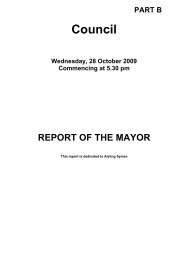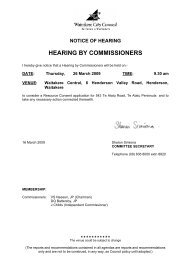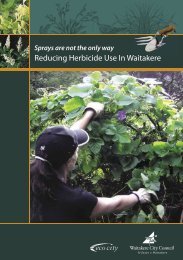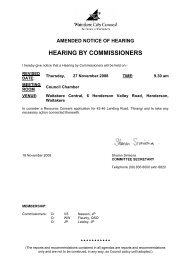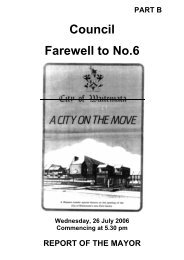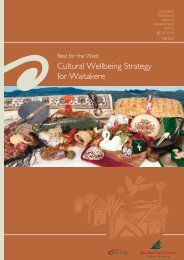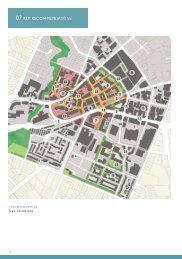'Street Lighting Update' produced by Local ... - Auckland Council
'Street Lighting Update' produced by Local ... - Auckland Council
'Street Lighting Update' produced by Local ... - Auckland Council
Create successful ePaper yourself
Turn your PDF publications into a flip-book with our unique Google optimized e-Paper software.
Streetlightingaudited against the ElectricityCommission rule on reconciliation ofun-metered loads. The return oninvestment is believed to be four to sixyears.Transit’s Sate Highway 16/18 ‘WesternFlyer’ project includes the Illumination ofthe 14km of motorway due to complete<strong>Auckland</strong>’s Western ring-route in 2012.Aurecon’s specialist lighting group[previously Connell Wagner] wasengaged to undertake the lightingdesign.The project enabled Aurecon tocompare the tender design as atraditional solution, to a more innovativecontemporary one, while maintainingcompliance with the current AustraliaNew Zealand Standard <strong>Lighting</strong> for Roadsand Public Places.Traditional thinking used 250-wattHPS, 16,000-hour lamps in large, ingressprotection (IP) 44 luminaires (forprotection from dust, dirt or water) withlow-tech reflectors, on 15-metre poles asthe benchmark for four lane motorways;30 per cent waste-light and low lightoutput ratios were typical.Contemporary thinking uses 150-watt,40,000-hour, twin-arc lamps in full cut-offluminaires, with sealed IP66, highperformanceoptics on 12-metre poles.Lamp surfaces are not visible to traffic oraerial views and a 40 per cent reductionin electrical load per pole has beenrealised.Reductions in electrical supplyinfrastructure, skyglow, maintenance,windage and visual pollution are justsome of the benefits adding to what isessentially a cost neutral basis.Careful attention to the design detail,innovation and the implementation ofcontemporary international road lightingtechnology has created an efficient,durable piece of New Zealandinfrastructure.A trial was undertaken <strong>by</strong> OdysseyEnergy Ltd for South Waikato District inTokoroa to test some of the latesttechnologies in lighting from Gough,Kaos and CosmoPolis.While they are more expensive to buythe lights’ high-quality manufacturingand well-designed optics mean they arefar cheaper to operate than traditionallights.Both lights are calculated to have a25-year operational lifespan.The existing 12 150 watt HPS lightswere around 10 years old.In order to establish a useful baselinenew Gough G600 150 HPS were installedduring the testing period on existingpoles and spacing.Once the measurements were takenfour sets of three luminaires wereinstalled on the existing poles andspacing.This was to achieve a different lightinglevel for each carriageway of BridgeStreet.The higher lighting level was tested onthe southern side of the road with threeiridium 140-watt CosmoPolis and threeKaos lights with 150-watt metal halideand was a test for lighting in centralbusiness district areas only.The lower lighting level was tested onthe northern side with three iridiumImage courtesy of we-ef lighting90-watt CosmoPolis and three Kaos100-watt HPS and was a test for lightingin V (Vehicle) category non-centralbusiness district areas (e.g. Bridge Streetaway from the central business districtarea, Balmoral Drive etc).The lights on the southern carriagewayrevealed it was possible to have greatlyimproved lighting (approximately 40 percent higher) with an attendant energysaving (approximately 10 per cent) andslightly reduced overall costs (6 per cent).The lights on the northern carriagewayrevealed that it was possible to have thesame overall lighting level (8 per centmore) with an attendant energy saving(approximately 40 per cent) and reducedoverall costs (28 per cent).The trial lights have a higher IP rating(ingress protection rating) Page 14New ZEALAND LOCAL GOVERNMENT - SEPTEMBER 2009 11



